An Emergency Alert Broadcast Based on the Convergence of 5G and ATSC 3.0
Abstract
1. Introduction
- We extended the general architectures into a 5G and ATSC 3.0 convergence network for emergency alert broadcast. The general architectures never reflect the interfaces among alerting authority, 5G CBS message generation, and AEA message application for the simultaneous delivery. We incorporated the interfaces into the convergence network. Furthermore, we added the functionality of CBS paging [8] to the convergence network, which enables mobile phones to receive AEA message as well as CBS message. Since the convergence network exhibits a unique architecture for emergency alert broadcast, the extension into the convergence network is a main contribution.
- We also proposed a novel framework for more reliable emergency alert broadcasts. The presented framework is utilized for a synchronization between CBS paging and AEA message in the 5G and ATSC 3.0 convergence network. The framework controls the delivery of AEA message, which guarantees that the AEA message is transmitted after the CBS paging is asserted. Since the framework exhibits a novel structure for the synchronization, the proposed framework is another contribution in this paper.
- In addition, we presented a novel procedure for simultaneous delivery of 5G CBS message and AEA message. Especially, the proposed procedure specifies the operations of the presented framework. The procedure guarantees that idle-state mobile phones can receive AEA message as well as CBS message using the CBS paging. Since the procedure exhibits a novel approach, which enables idle mobile phones to simultaneously receive AEA message and CBS message using the CBS paging, the presented procedure is also a contribution in this paper.
2. Conventional Works
2.1. 5G CBS Protocol
2.2. AEA Protocol
3. The Novel Emergency Alert Broadcast Approach Based on the Convergence
3.1. The Convergence Architecture and the Scenario
- When an emergency occurs, the alerting authority simultaneously sends an emergency alert message to the CBE/CBCF of the 5G and the AEA application of the ATSC 3.0.
- The CBCF converts the emergency alert message to the CBS message according to the CBS protocol [12]. Then, the CBCF sends the CBS message to the AMF in the 5G core network. Based on the received emergency alert message, the AEA application generates the modified AEAT and the corresponding multimedia files (NRT components) according to the AEA protocol [24]. Then, the modified AEAT and the NRT components are transmitted to the ATSC 3.0 core network using the UDP/IP protocol.
- The AMF simultaneously sends the CBS message to the N3IWF and the selected base stations of the RAN.
- The N3IWF extracts the CBS ID (as a trigger information) from the CBS message, and sends it to the ATSC 3.0 core network.
- The selected base stations broadcast the CBS paging signals to the mobile phones in the corresponding cells. As soon as the paging signals are received, the mobile phones become ready for the CBS message and the AEA message (which includes the modified AEAT and the NRT components) from the 5G base stations and the ATSC 3.0 broadcast stations, respectively.
- In the ATSC 3.0 core network, the received trigger information causes the modified AEAT and the NRT components to be transmitted to the ATSC 3.0 broadcast stations.
- The 5G base stations and the ATSC 3.0 stations broadcast the CBS message and the AEA message, respectively, to the mobile phones in the corresponding cells.
- The AMF sends the CBS message to the N3IWF as well as the selected base stations. For the transmission of the CBS message, the AMF adopts the N2 protocol stack [34], which consists of 5G application protocol (5G-AP), SCTP, IP, layer 2 (L2), and layer 1 (L1). The 5G-AP includes the CBS message in Figure 7.
- The N3IWF acts as a relay between the AMF and the ATSC 3.0 core network. For the connection to the AMF, the N3IWF adopts the N2 protocol stack. For the connection to the ATSC 3.0 core network, the N3IWF relies on the ATSC 3.0 protocol stack, which consists of ATSC 3.0 application protocol (ATSC3.0-AP), UDP, IP, ATSC 3.0 link layer protocol (ALP), and ATSC 3.0 PHY. The N3IWF extracts the CBS ID from the CBS message, and sends the CBS ID to the multiplexer in the ATSC 3.0 core network. The ATSC3.0-AP includes the extracted CBS ID in Figure 7.
- In the ATSC 3.0 core network, the multiplexer uses the CBS ID as the trigger information. If the received CBS ID is matched to the Header<CBS ID> of the modified AEAT, the multiplexer multiplexes the AEAT and the NRT components into the AEA message. Otherwise, the multiplexer suspends the multiplexing operation until the received trigger information is matched. Therefore, the CBS ID can be used as the trigger information for a synchronization between the CBS paging signal and the AEA message.
- In the ATSC 3.0 core network, the ATSC 3.0 gateway transforms the AEA message into a frame unit on the physical layer. Then, the ATSC 3.0 gateway transmits the frame to the ATSC 3.0 modulator.
- The ATSC 3.0 modulator converts the physical-layer frame to the waveform signal for broadcast.
- The ATSC 3.0 broadcast station broadcasts the waveform signal for the AEA message.
3.2. Latency Performace for the Proposed Emergency Alert Broadcast Approach
4. Simulation Results
5. Conclusions
Author Contributions
Funding
Conflicts of Interest
References
- Kuru, K.; Khan, W. A framework for the synergistic integration of fully autonomous ground vehicles with smart city. IEEE Access 2020, 9, 923–948. [Google Scholar] [CrossRef]
- Lee, Y.L.; Qin, D.; Wang, L.-C.; Sim, G.H. 6G massive radio access networks: Key applications, requirements and challenges. IEEE Open J. Veh. Technol. 2020, 2, 54–66. [Google Scholar] [CrossRef]
- Javidroozi, V.; Shah, H.; Feldman, G. Urban computing and smart cities: Towards changing city processes by applying enterprise systems integration practices. IEEE Access 2019, 7, 108023–108034. [Google Scholar] [CrossRef]
- Wang, F.; Pei, Z.; Dong, L.; Ma, J. Emergency resource allocation for multi-period post-disaster using multi-objective cellular genetic algorithm. IEEE Access 2020, 8, 82255–82265. [Google Scholar] [CrossRef]
- Chang, D.; Cui, L.; Huang, Z. A cellular-automaton agent-hybrid model for emergency evacuation of people in public places. IEEE Access 2020, 8, 79541–79551. [Google Scholar] [CrossRef]
- Elsawy, H.; Dai, W.; Alouini, M.-S.; Win, M.Z. Base station ordering for emergency call localization in ultra-dense cellular networks. IEEE Access 2017, 6, 301–315. [Google Scholar] [CrossRef]
- Jeon, I.; Song, M.; Chang, S.; Choi, S.J.; Lee, Y.-T. A signaling emergency alert system multiplexed with T-DMB channel for emergency alert service. IEEE Trans. Consum. Electron. 2015, 61, 16–23. [Google Scholar] [CrossRef]
- Song, M.; Jun, K.; Chang, S. An efficient multiplexing method of T-DMB and cell broadcast service in emergency alert systems. IEEE Trans. Consum. Electron. 2014, 60, 549–557. [Google Scholar] [CrossRef]
- Chang, S. A synchronous cooperative communication for emergency alert broadcast based on cellular systems. J. Broadcast Eng. 2014, 19, 184–194. [Google Scholar] [CrossRef]
- Zhu, Y.; Gao, X.; Willson, J.K.; Ma, C.; Jue, J.P.; Wu, W. Improving cell broadcasting scheme to support multi-lingual service in wireless networks. IEEE Commun. Lett. 2009, 13, 634–636. [Google Scholar] [CrossRef]
- Sengupta, A.; Alvarino, A.R.; Catovic, A.; Casaccia, L. Cellular terrestrial broadcast—physical layer evolution from 3GPP release 9 to release 16. IEEE Trans. Broadcast. 2020, 66, 459–470. [Google Scholar] [CrossRef]
- 3GPP TS 23.041 V16.2.0: Technical Realization of Cell Broadcast Service (CBS). Release 16. October 2019.
- ATIS-0700023: Feasibility Study of LTE WEA Message Length. October 2015.
- ATIS-0700026: Feasibility Study for WEA Supplemental Text. December 2015.
- Kim, M.; Chang, S. A novel receiver for reliable IoT communications based on Zigbee under frequency-selective indoor environments. IEICE Trans. Fundam. 2017, e100-a, 361–365. [Google Scholar] [CrossRef]
- Kim, M.; Chang, S. A consumer transceiver for long-range IoT communications in emergency environments. IEEE Trans. Consum. Electron. 2016, 62, 226–234. [Google Scholar] [CrossRef]
- Lee, Y.-H.; Kim, G.; Park, S.-R.; Lee, Y.-T.; Kim, N. An efficient emergency broadcasting signal multiplexing method for supporting the legacy T-DMB receivers in break-in system. IEEE Trans. Consum. Electron. 2011, 57, 1550–1555. [Google Scholar] [CrossRef]
- Baek, M.-S.; Lee, Y.-H.; Kim, G.; Park, S.-R.; Lee, Y.-T. Development of T-DMB emergency broadcasting system and trial service with the legacy receivers. IEEE Trans. Consum. Electron. 2013, 59, 38–44. [Google Scholar] [CrossRef]
- Choi, S.-J.; Kwon, D.-B.; Kim, J.-Y.; Oh, K.-S.; Chang, T.-U.; Hahm, Y.-K. Design of T-DMB automatic emergency alert service standard: Part 1 requirements analysis. J. Broadcast Eng. 2007, 12, 230–241. [Google Scholar] [CrossRef][Green Version]
- ATSC Standard: ATSC 3.0 System (A/300). September 2019.
- ATSC Standard: System Discovery and Signaling (A/321). March 2016.
- ATSC Standard: Physical Layer Protocol (A/322). December 2018.
- ATSC Standard: Link-Layer Protocol (A/330). May 2019.
- ATSC Standard: Signaling, Delivery, Synchronization, and Error Protection (A/331). June 2019.
- Gomez-Barquero, D.; Caldwell, M.W. Broadcast television spectrum incentive auctions in the U.S.: Trends, challenges, and opportunities. IEEE Commun. Mag. 2015, 53, 50–56. [Google Scholar] [CrossRef]
- Kim, H.; Kim, J.; Park, S.I.; Lee, J.-Y.; Hur, N.; Simon, M.; Aitken, M.; Gage, K. An improved decoding scheme for emergency alert wake-up bits in ATSC 3.0. IEEE Trans. Broadcast. 2020, 66, 1–8. [Google Scholar] [CrossRef]
- Kim, H.; Kim, J.; Park, S.I.; Lee, J.-Y.; Hur, N.; Simon, M.; Aitken, M.; Gage, K. A new decoding scheme of emergency alert wake-up bits in ATSC 3.0. In Proceedings of the IEEE International Symposium on Broadband Multimedia Systems and Broadcasting, Jeju, Korea, 5–7 June 2019. [Google Scholar]
- 3GPP TS 24.502 V17.1.0: Access to the 3GPP 5G Core Network (5GCN) via Non-3GPP Access Networks (N3AN). Stage 3, Release 17. December 2020.
- 3GPP TS 29.500 V16.5.0: 5G System; Technical Realization of Service Based Architecture. Stage 3, Release 16. September 2020.
- Zhang, L.; Li, W.; Wu, Y.; Prasad, A.; Park, S.-I.; Hur, N. Using non-orthogonal multiplexing for enhancing unicast-broadcast transmission capacity in 5G. In Proceedings of the 2nd 5G World Forum, Dresden, Germany, 30 September–2 October 2019; pp. 214–219. [Google Scholar]
- Simon, M.; Kofi, E.; Libin, L.; Aitken, M. ATSC 3.0 broadcast 5G unicast heterogeneous network converged services starting release 16. IEEE Trans. Broadcast. 2020, 66, 449–458. [Google Scholar] [CrossRef]
- Ghosh, A.; Maeder, A.; Baker, M.; Chandramouli, D. 5G evolution: A view on 5G cellular technology beyond 3GPP release 15. IEEE Access 2019, 7, 127639–127651. [Google Scholar] [CrossRef]
- 3GPP TS 38.331 V15.8.0: Radio Resource Control (RRC) protocol specification. Release 15. December 2019.
- 3GPP TS 29.518 V16.2.0: Access and Mobility Management Services. Stage 3, Release 16. December 2019.
- Hikmaturokhman, A.; Suryanegara, M.; Ramli, K. A comparative analysis of 5G channel model with varied frequency: A case study in Jakarta. In Proceedings of the International Conference on Smart Computing & Communications, Sarawak, Malaysia, 28–30 June 2019. [Google Scholar]
- Digital Video Broadcasting (DVB): Implementation Guidelines for a Second Generation Digital Terrestrial Television Broadcasting System (DVB-T2), ETSI EN 102 831 v1.2.1 2012-08.
- Goldsmith, A. Wireless Communications; Cambridge University Press: Cambridge, UK, 2005. [Google Scholar]
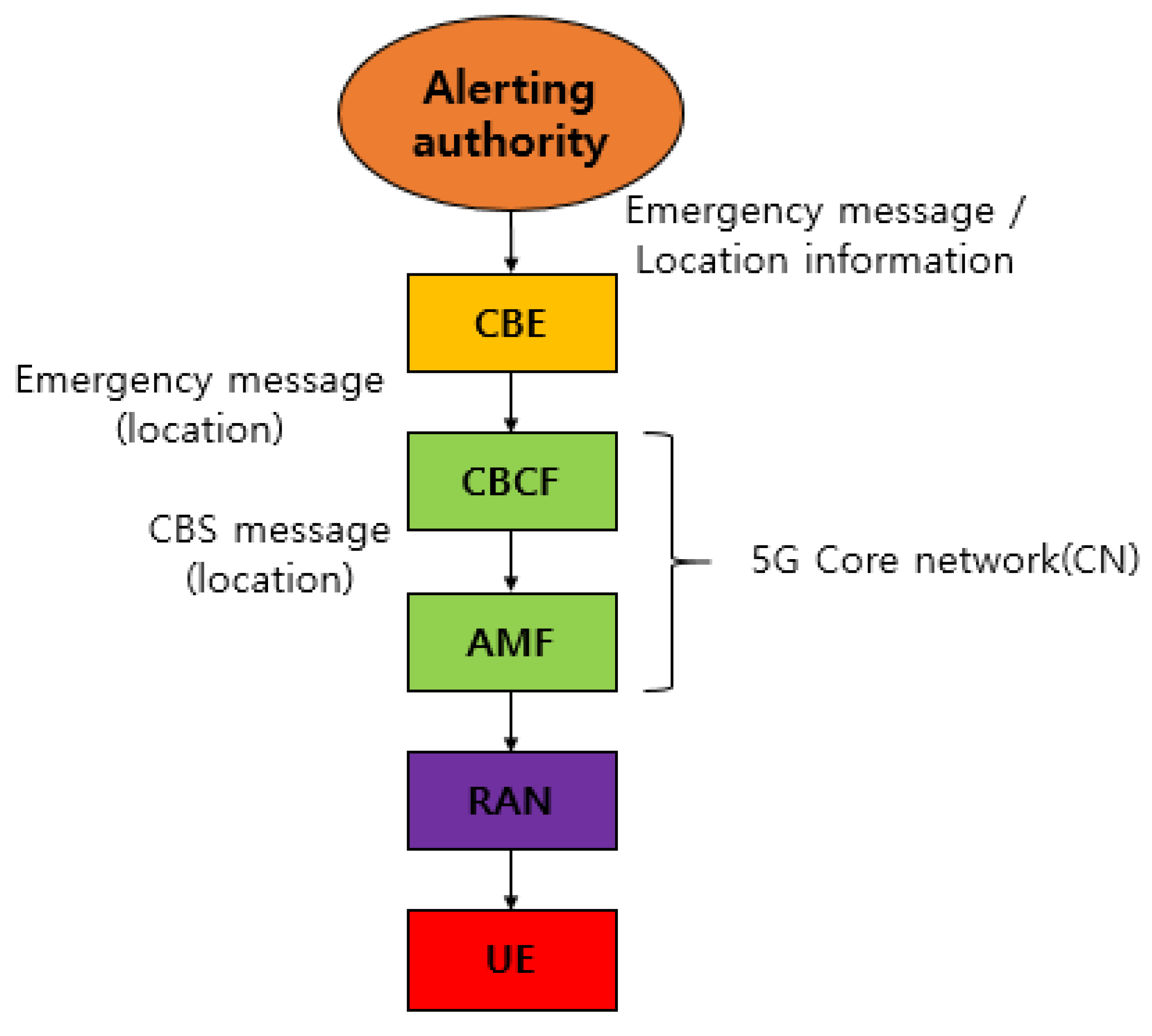
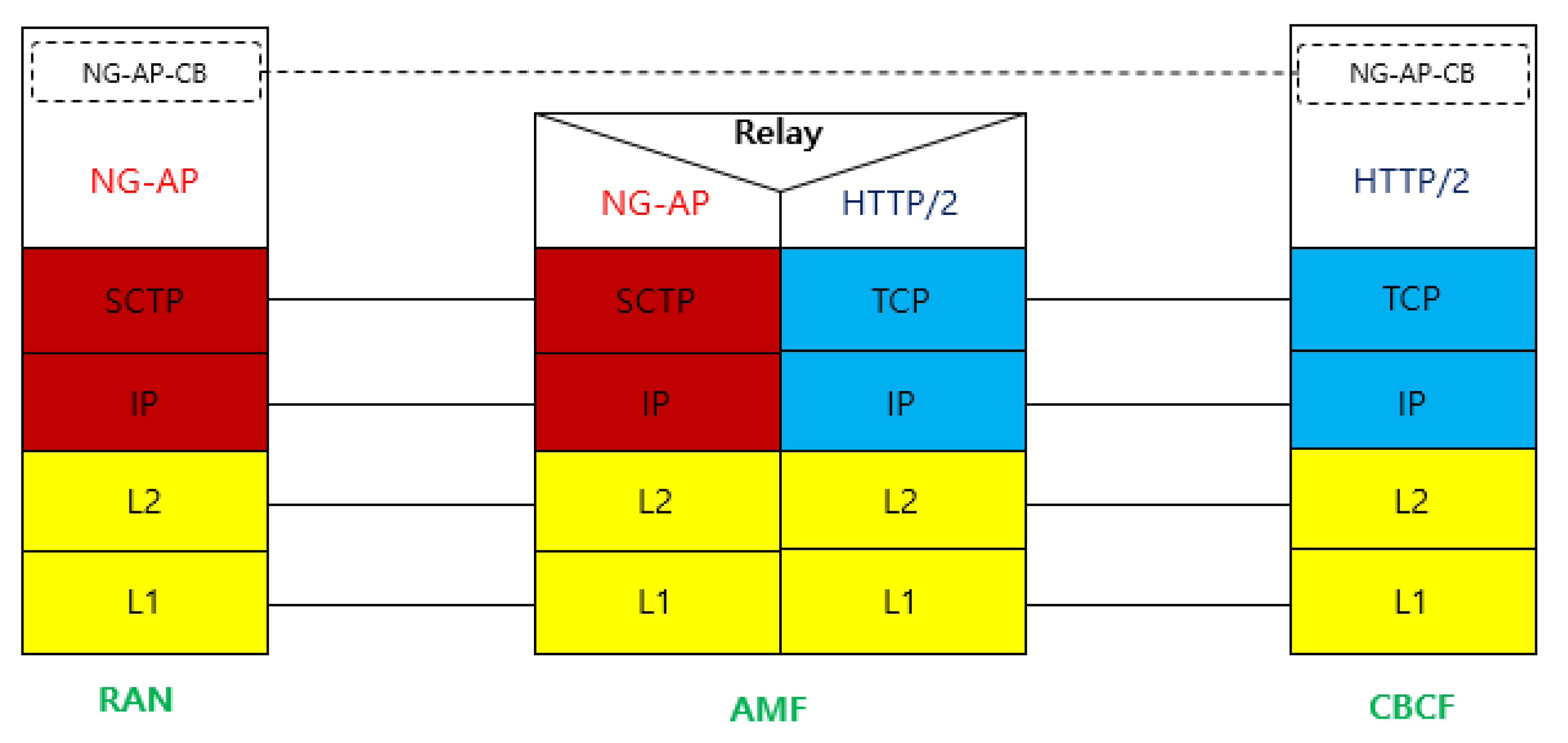
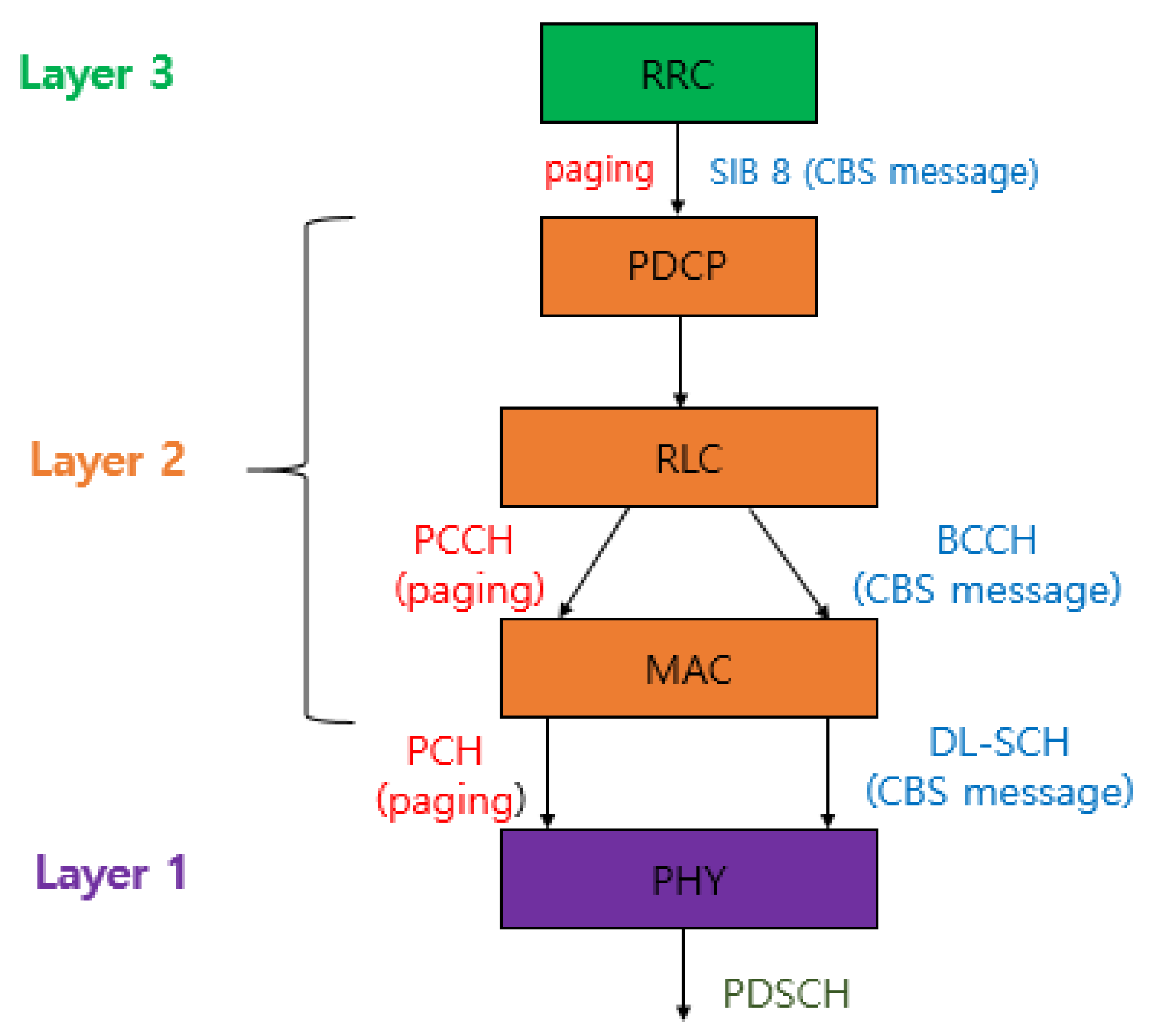
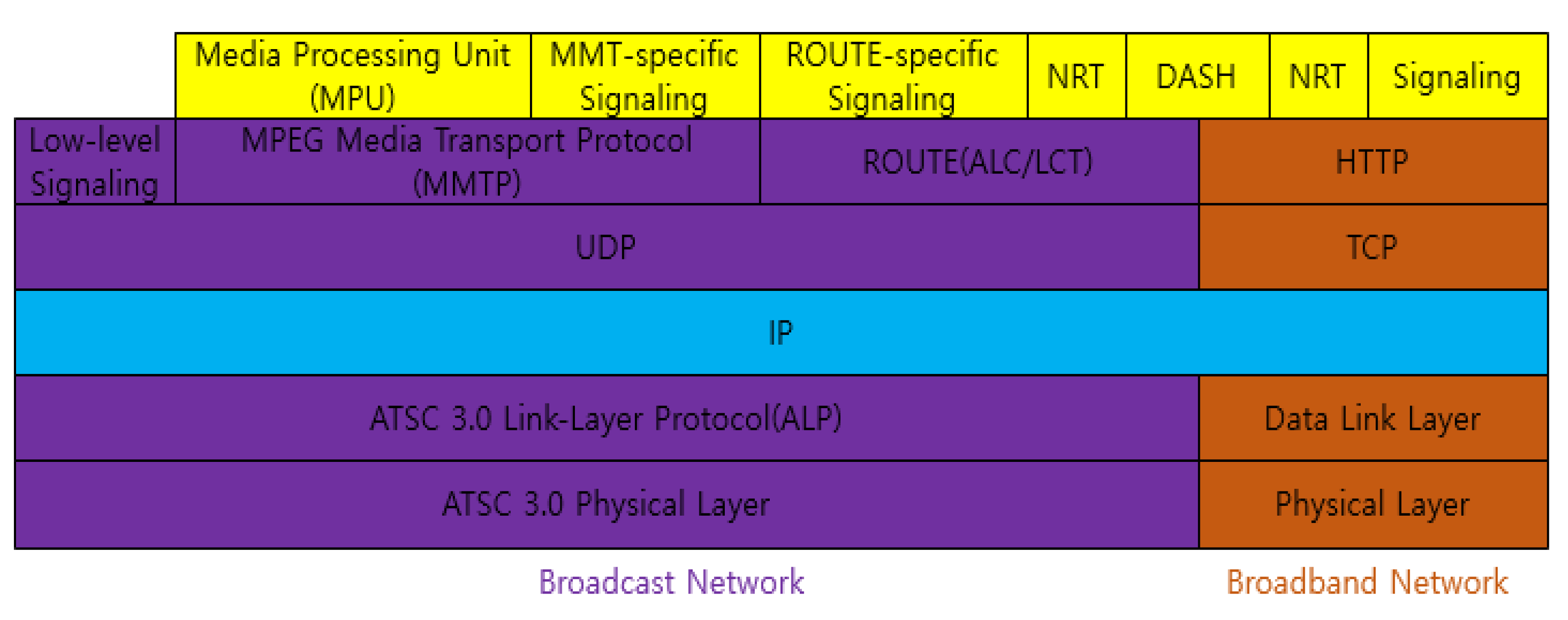

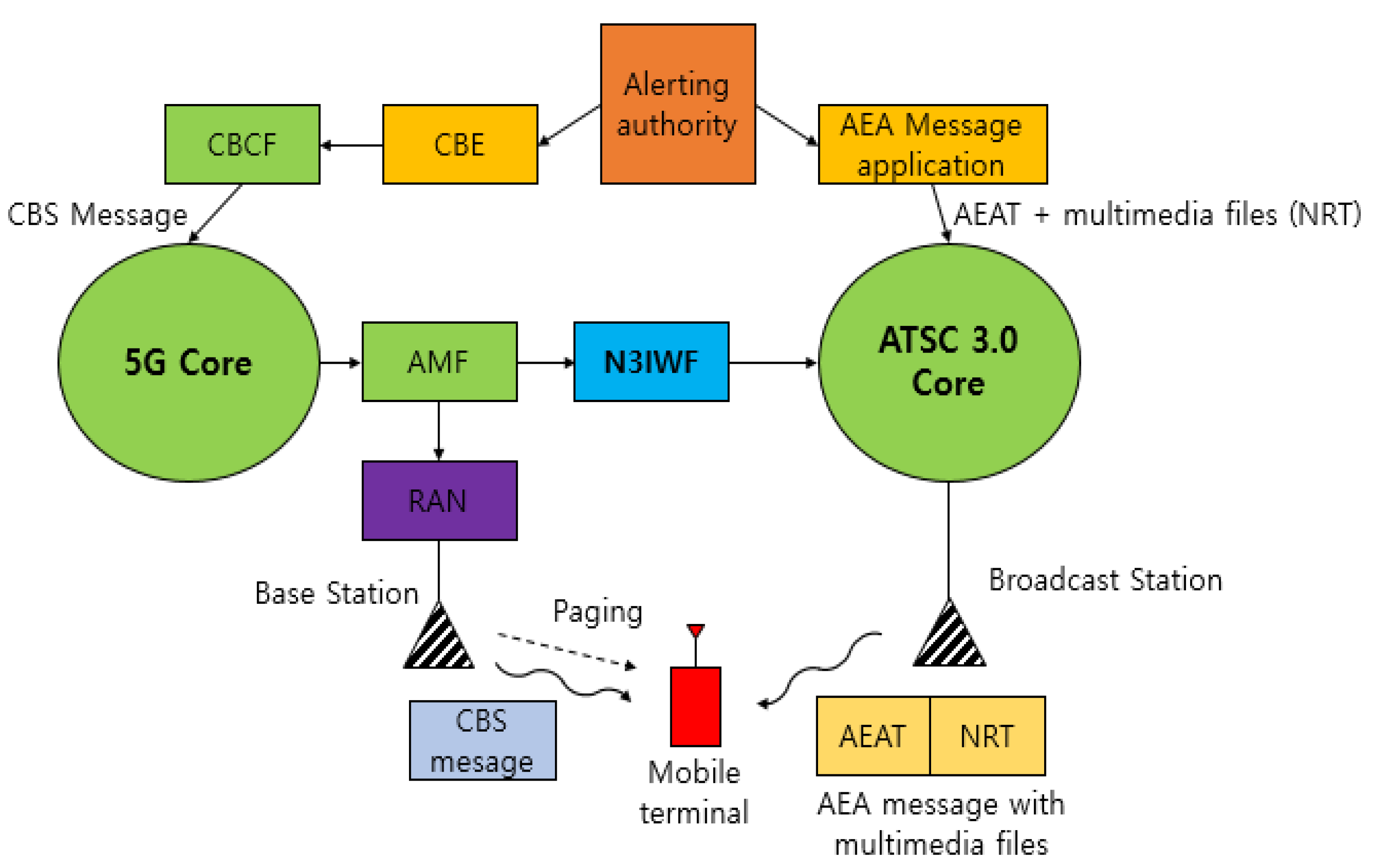
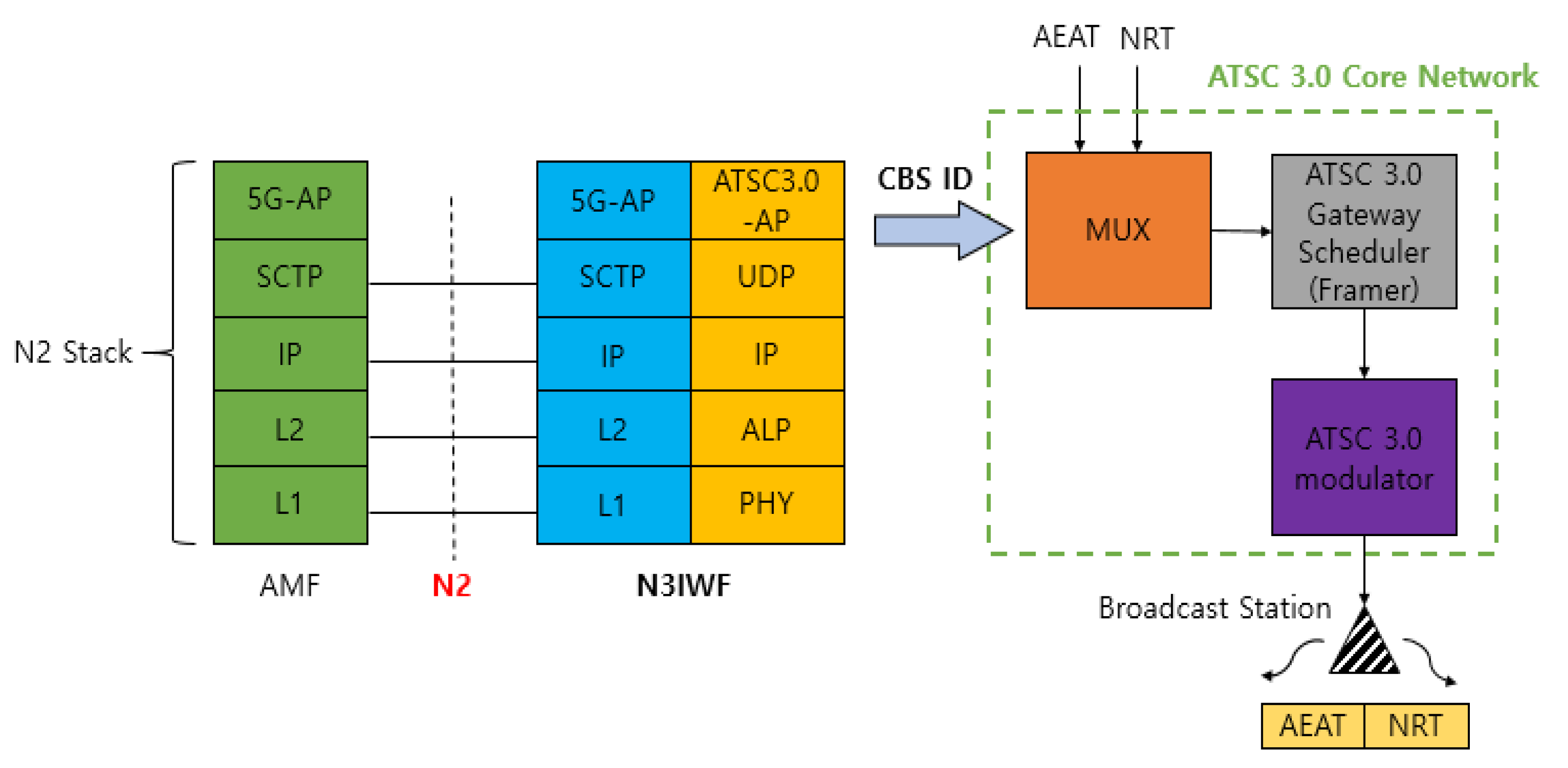
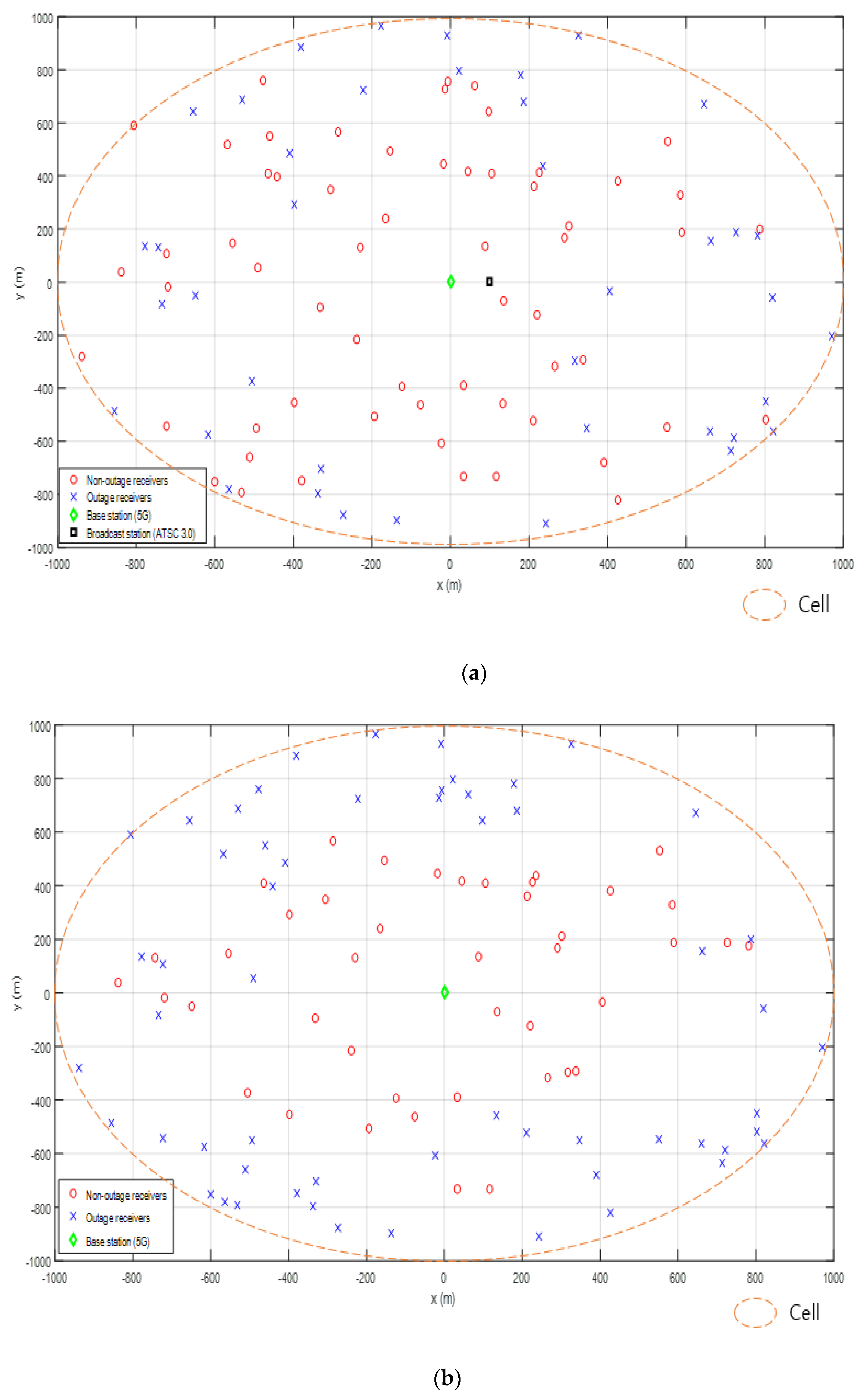
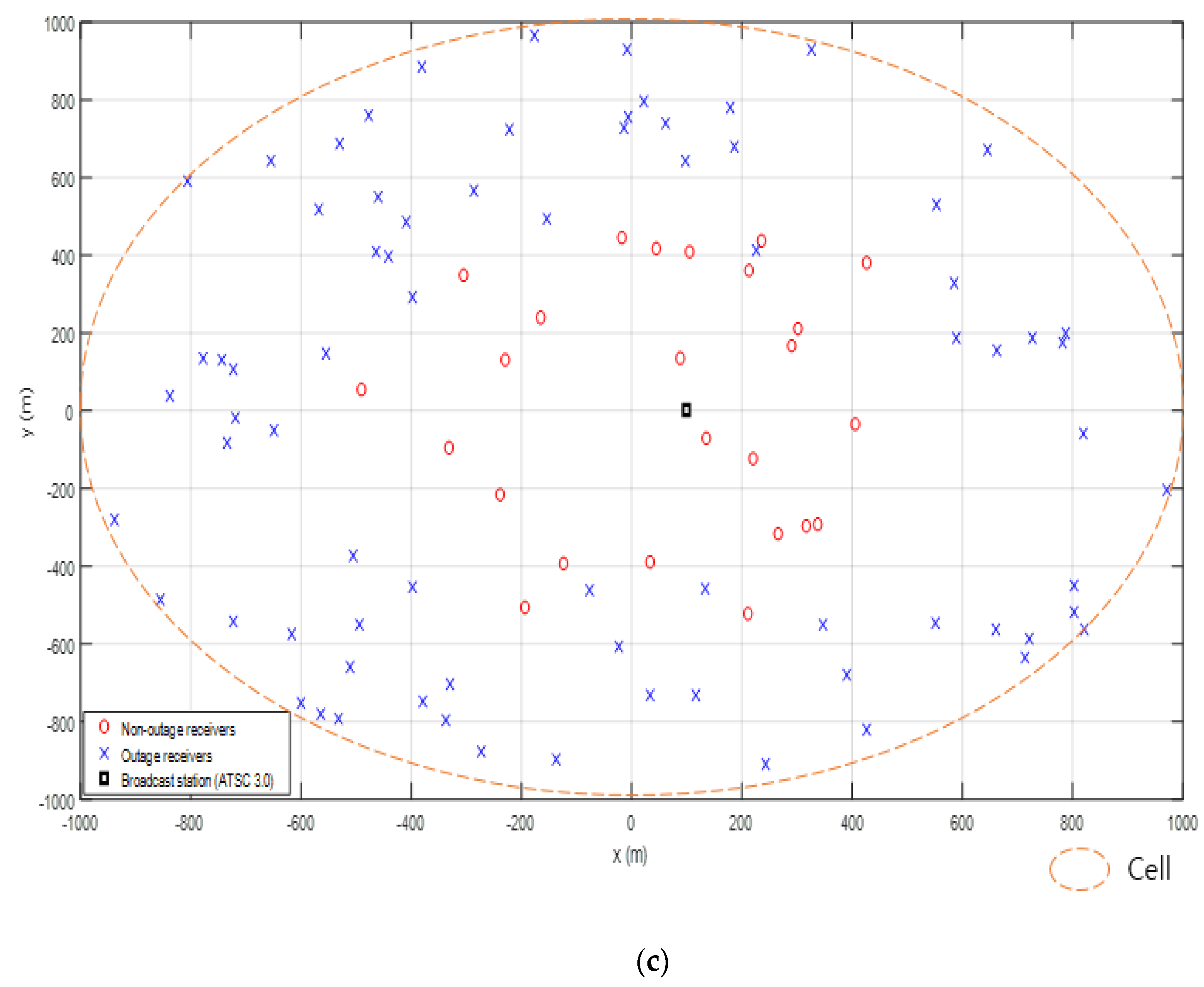
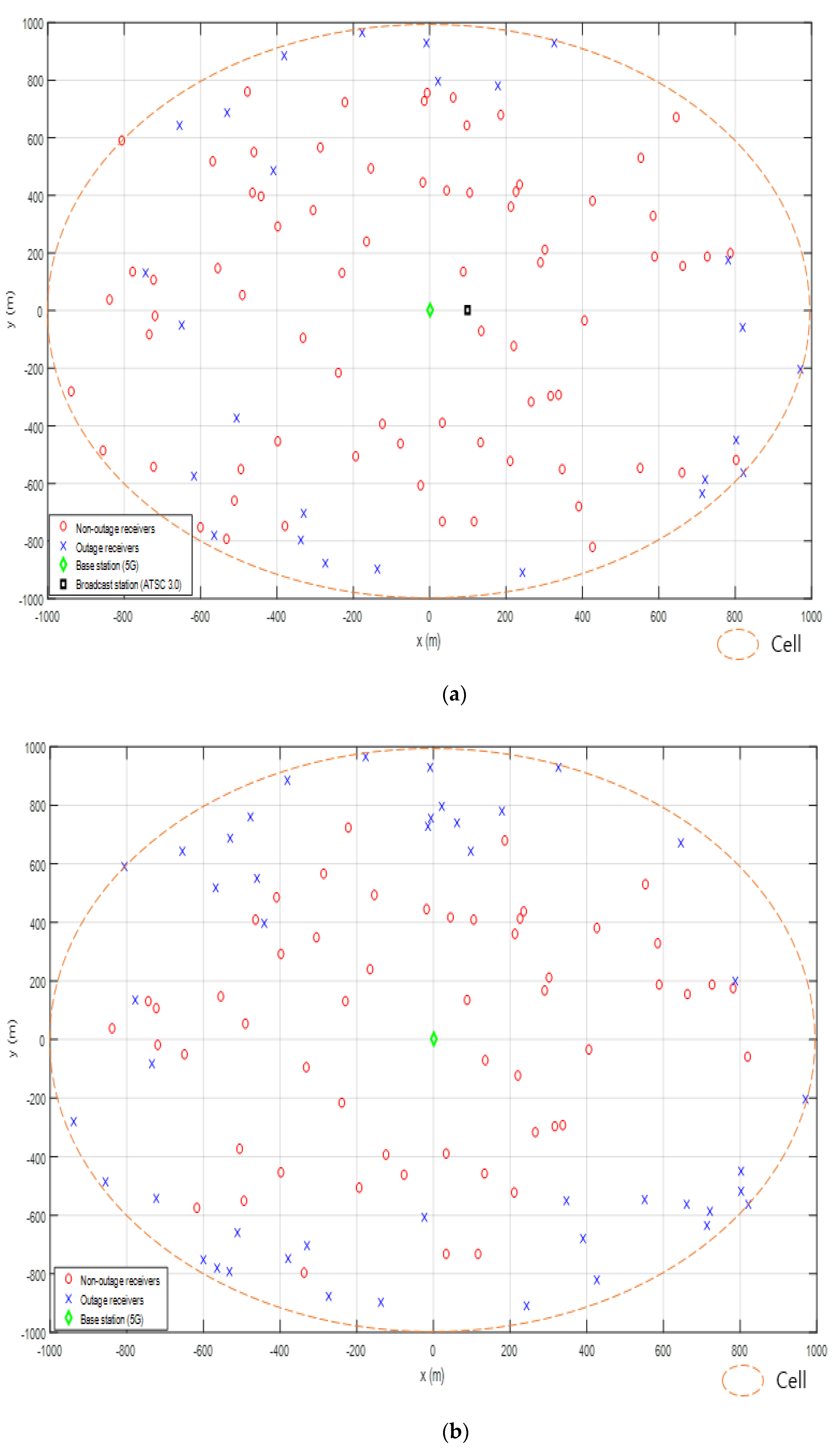

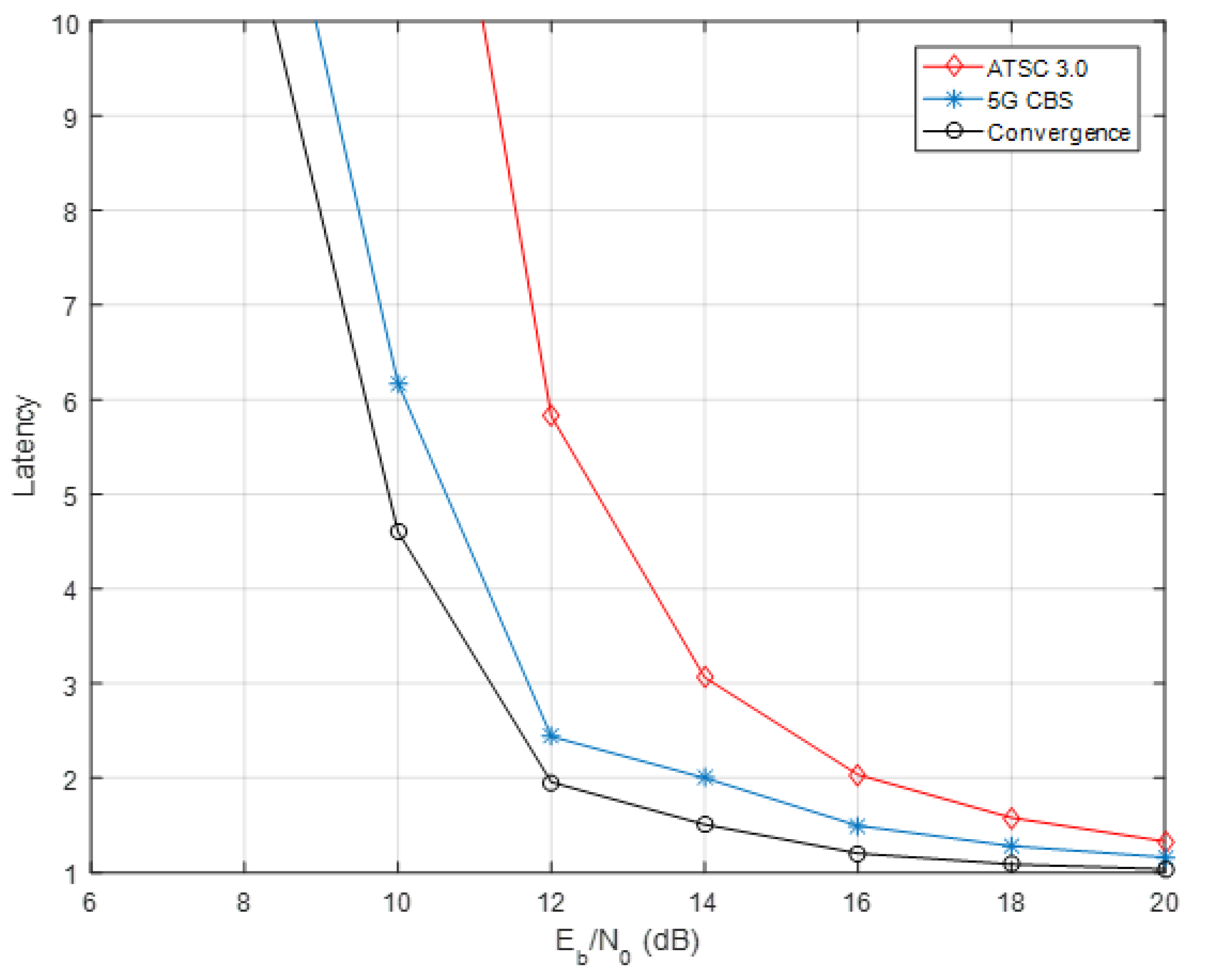
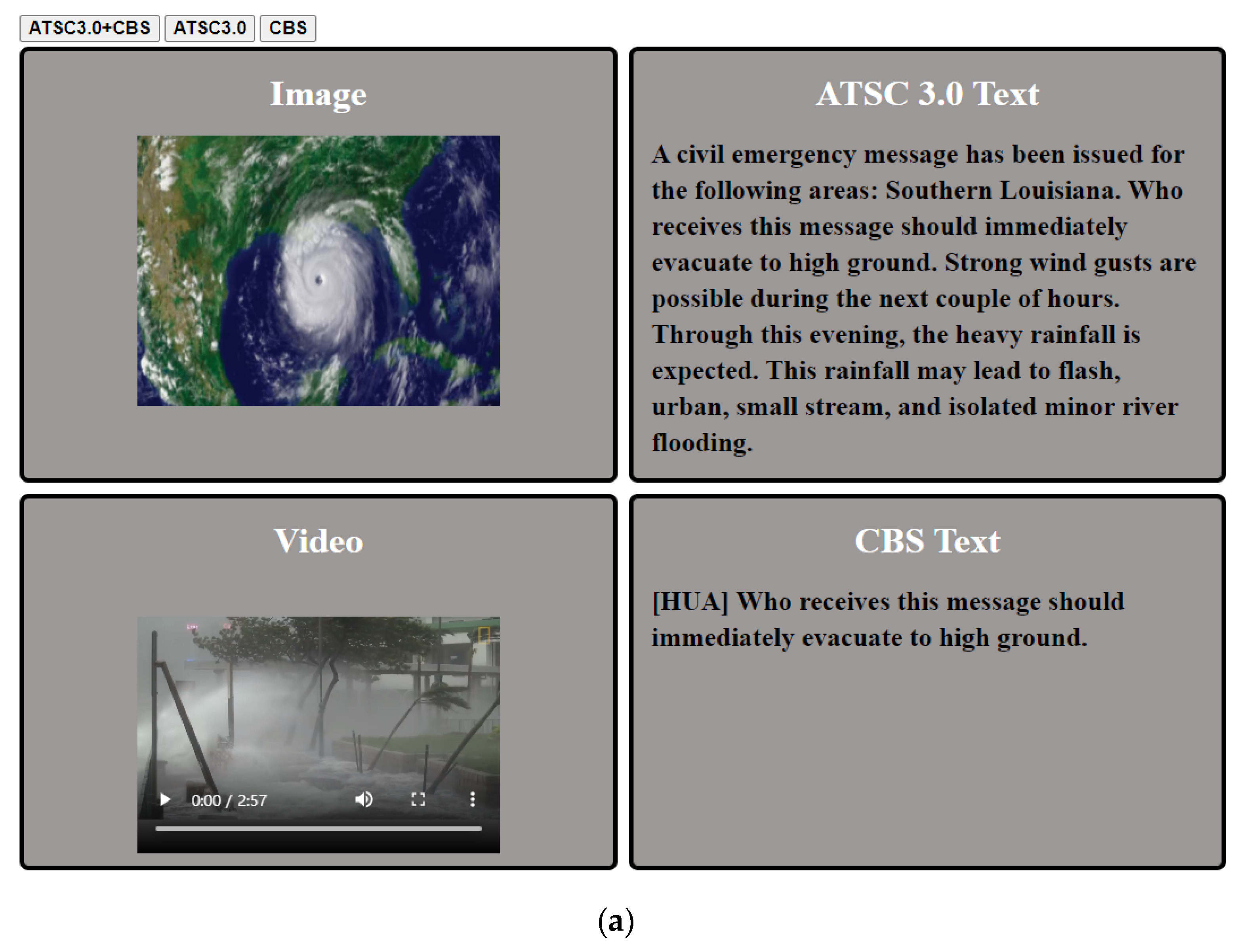
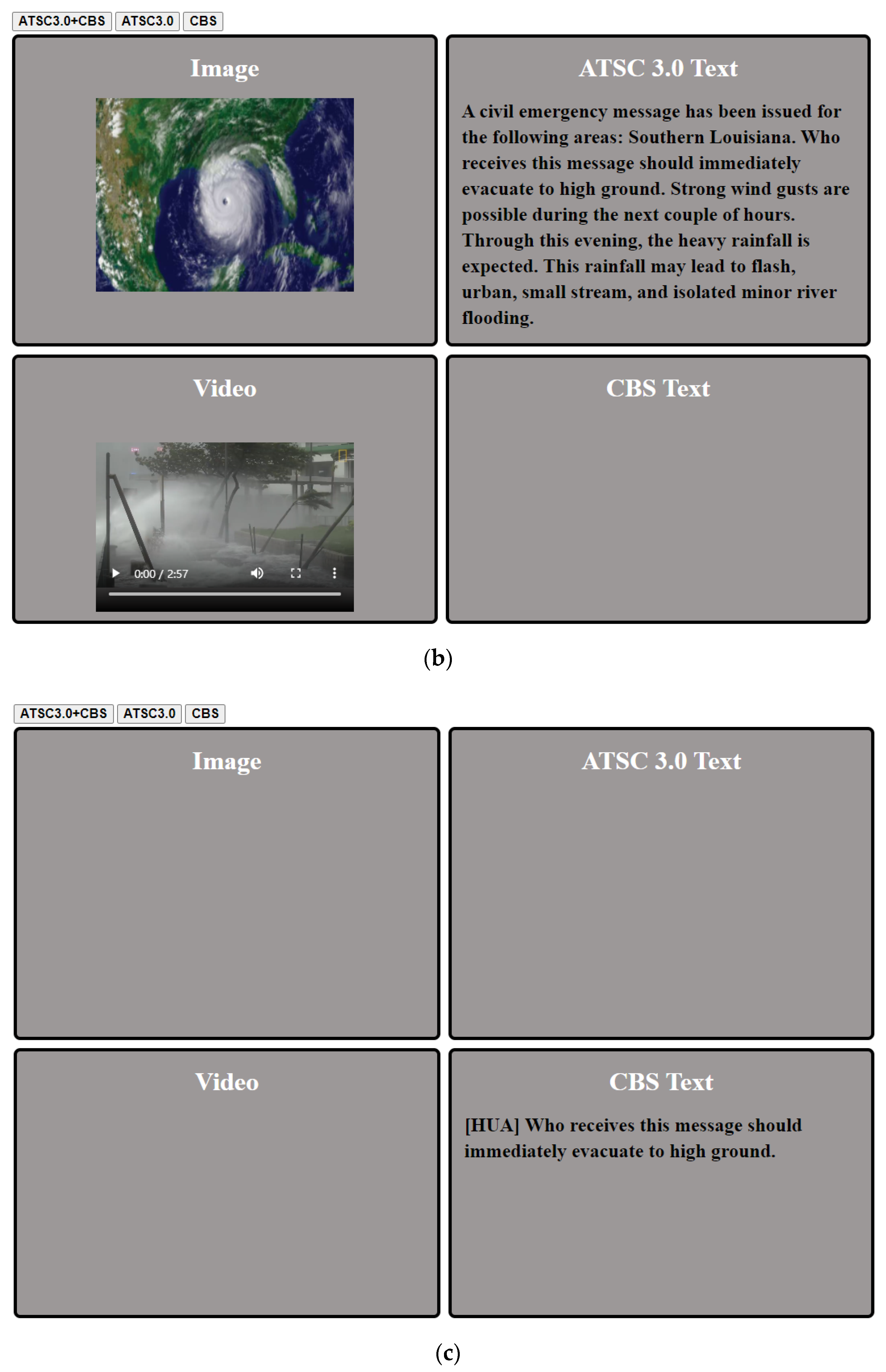
| Element | Description |
|---|---|
| AEA | AEA message format |
| <aeaId> | The identifier of AEA message |
| <audience> | The intended distribution of the AEA message |
| <wakeup> | A true/false value for whether the wake-up field was activated for the emergency that the <aeaId> message describes |
| Header | The container for the basic alert envelope |
| <effective> | The effective time of the AEA message |
| <expires> | The expires time of the AEA message |
| <EventCode> | A code identifying the event type of the AEA message |
| <EventDesc> | A short plain text description of the emergency event |
| <Location> | The geographic code that identifies the affected area of the AEA message |
| AEAText | The specific informative text of the AEA message |
| LiveMedia | The information of emergency-related real-time (live) audio/video service, which is delivered via broadcast stream |
| Media | The component parts of the multimedia resource |
| <lang> | The code denoting the language of the respective element media |
| < mediaDesc> | A short text description of the type and content of the media file |
| < mediaType> | Text identifying the intended use of the associated media |
| < url> | The identifier of the media file |
| < alternateUrl> | Alternate URL of the media file when it is also available via non-broadcast delivery |
| < contentType> | The internet assigned numbers authority (IANA) media type of media content referenced by Media<url> |
| <contentLength> | The size (bytes) of media content referenced by Media<url> |
| < mediaAssoc> | The URI of another Media element with which this attribute is associated as described in <mediaType> |
| Value | Meaning |
|---|---|
| 00 | No emergency to wake up devices is currently signaled |
| 01 | Emergency to wake up devices—setting 1 |
| 10 | Emergency to wake up devices—setting 2 |
| 11 | Emergency to wake up devices—setting 3 |
| Elements | Description |
|---|---|
| Header | |
| <CBS flag> | A true/false value for whether the AEAT is associated with the CBS message |
| <CBS ID> | The identifier of the associated CBS message |
| Parameters | Value/Property |
|---|---|
| Carrier frequency of 5G | 3.5 GHz |
| Carrier frequency of ATSC 3.0 | 600 MHz |
| Fading channel for 5G | Jakarta channel (Rayleigh) |
| Fading channel for ATSC 3.0 | TU−6 (Rayleigh) |
| Cell radius | 1 Km |
| Number of receivers per cell | 100 |
| Distribution of the receivers | Uniform |
| Total transmit power | 1 W |
Publisher’s Note: MDPI stays neutral with regard to jurisdictional claims in published maps and institutional affiliations. |
© 2021 by the authors. Licensee MDPI, Basel, Switzerland. This article is an open access article distributed under the terms and conditions of the Creative Commons Attribution (CC BY) license (http://creativecommons.org/licenses/by/4.0/).
Share and Cite
Byun, Y.-K.; Chang, S.; Choi, S.J. An Emergency Alert Broadcast Based on the Convergence of 5G and ATSC 3.0. Electronics 2021, 10, 758. https://doi.org/10.3390/electronics10060758
Byun Y-K, Chang S, Choi SJ. An Emergency Alert Broadcast Based on the Convergence of 5G and ATSC 3.0. Electronics. 2021; 10(6):758. https://doi.org/10.3390/electronics10060758
Chicago/Turabian StyleByun, Yoon-Kwan, Sekchin Chang, and Seong Jong Choi. 2021. "An Emergency Alert Broadcast Based on the Convergence of 5G and ATSC 3.0" Electronics 10, no. 6: 758. https://doi.org/10.3390/electronics10060758
APA StyleByun, Y.-K., Chang, S., & Choi, S. J. (2021). An Emergency Alert Broadcast Based on the Convergence of 5G and ATSC 3.0. Electronics, 10(6), 758. https://doi.org/10.3390/electronics10060758






